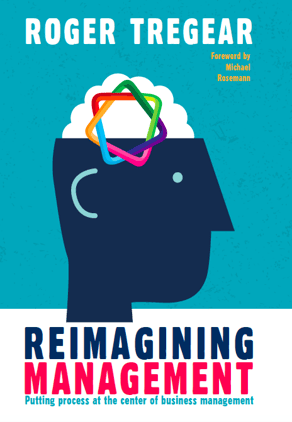

For most organizations, the time has passed when improving performance can be achieved by ‘simply’ reducing budgets and assuming those affected will adjust to the change. After years of budget cuts and efficiency dividends, and not helped by too many failed process improvement projects, the easy changes are done, contingency resources are extinct, and further change is deep, structural, disruptive, and difficult.
Organizations need to step back from day-to-day functional issues and reimagine themselves as value-creation and delivery flows. Management needs its own disruption; the first transformation required is of management itself.
Reviewers from across the globe have praised Reimagining Management as a ‘superb reference book that shows how to establish and implement BPM in any organization’ and a ‘modern classic for the BPM space!’
The breakthrough impact of the book has been recognized in review comments such as: ‘Roger has unlocked the mystery of business process management’, and ‘Reimagining Management defines the missing link’, and finally ‘This book is a must for any leader wanting to reframe, enrich, and refocus management to get different results.’
Reimagining Management introduces the concepts of the 7Enablers of BPM and the Tregear Circles as part of a practical framework for the positive and controlled evolution of management practice.
This approach to organizational management that focuses on the creation, accumulation, and delivery of value to customers and other stakeholders.
A core principle of Reimagining Management is the primacy of process. This principle says that the only way any organization can create, accumulate, and deliver value to its customers, itself, and other stakeholders, is through collaboration across the organization.
Can any box on the organization chart, by itself, deliver value outside the organization? No, it can’t. Who oversees work that happens via collaboration across that chart? Nobody? Is that a good idea?
This is the meaningful message of process-based management.
Using this book as a guide, it’s time to reimagine management.
Below are four articles dealing with topics and ideas discussed in this book.
A Business Process Architecture is the primary artifact of process management and improvement. If you don't have a BPA, you aren't doing process management. If you don't have a documented and agreed understanding of the relationships and interdependencies between your key business processes, then you can't be sure you are really doing effective process improvement. Read more >>
Measuring process performance is fundamental. Whether our intent is pragmatic process improvement or the more holistic goals of process management, we must measure process performance. Read more >>
The core process governance cycle is to measure the process performance gap, assess what, if anything, needs to be done now to adjust that gap, and then to take the required action. Then repeat, forever. Read more >>
'Continuous problem finding' requires the right mindset and toolset, supported by leadership and a personal, team and organizational culture that values improvement. Read more >>